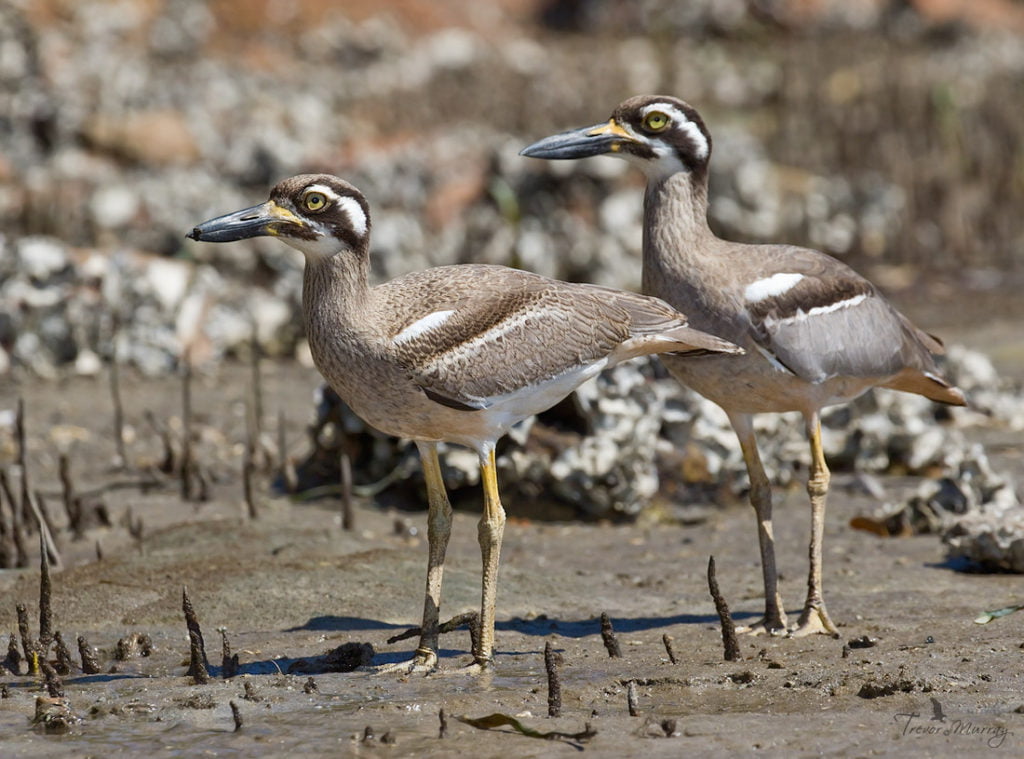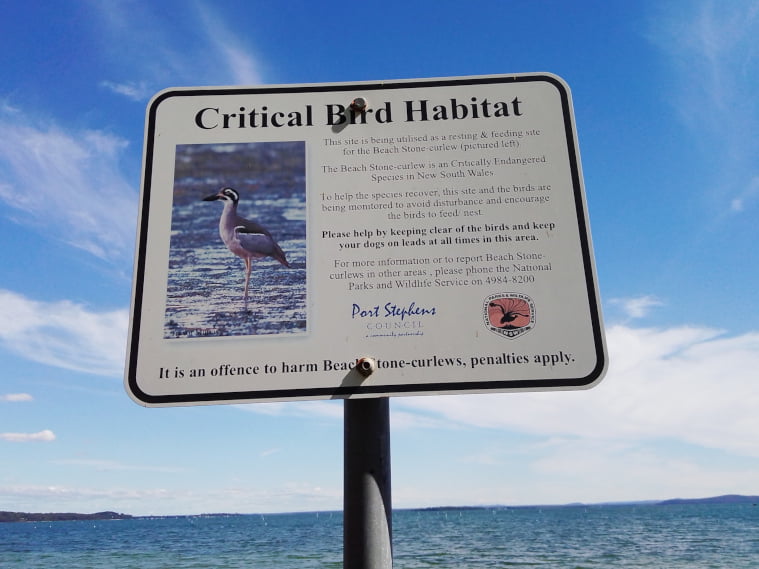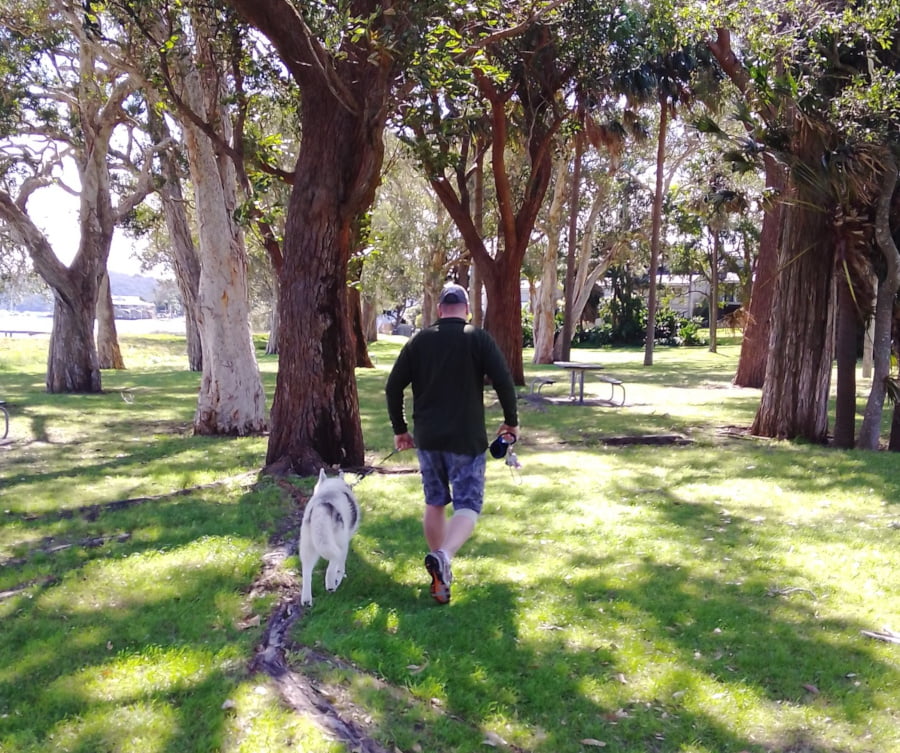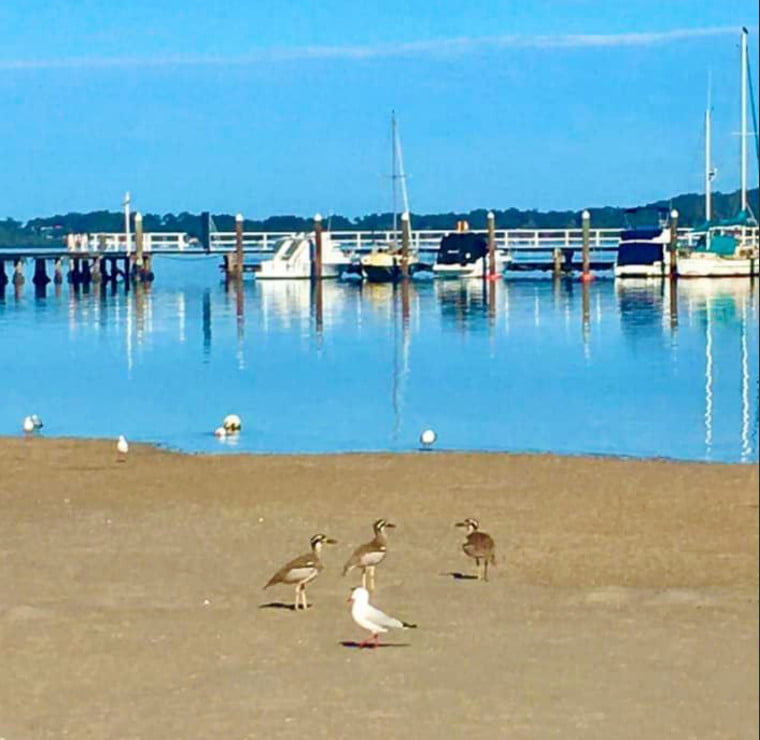Beach Stone-curlews at Sunset
Did you know that we have a very rare bird nesting right here in Soldier’s Point on the Tomaree Peninsula?
Local birdwatchers have noted that a pair of Critically Endangered Beach Stone-curlews (Esacus magnirostris) has been resident here in Port Stephens since at least 2011. They are a beach-nesting shorebird species and have been raising a single chick on safe havens such as nearby islands almost every year. Most days, except in the breeding season, the pair can be observed around Soldiers Point and the wider estuary. Local residents usually spot them when they fly over to Sunset Beach to forage on the exposed tidal flats where their favourite food Soldier Crabs are found.
These beautiful birds can sometimes be seen through the day but generally they are crepuscular (active at dawn & dusk). At night during the breeding season, you might hear a harsh, wailing weer-loo call, similar but more shrill than that of the Bush Stone-curlew (Burhinus grallarius). They are the largest of the beach-nesting birds – up to 550mm in length and with a wingspan of 1.1m. They have yellow eyes, a large bill, a short tail and strong legs.

Photo © Trevor Murray
Pictured here, local photographer and researcher, Trevor Murray has captured the finer details of the plumage transition between the juvenile and the adult bird.Trevor writes: “Some areas to note as the bird ages are: more marked definition between the yellow and dark areas of the bill; decreasing size of the white patch on the side of head; decreasing amount of light brown colour and flecking in the feathering; changing presence and definition in the white ‘shoulder’ wing markings.” 1
Note there are distinct differences between the Beach Stone-curlew and the Bush variety. See Neil Fraser’s article about the Bush Stone-curlew here.
WHAT ECONETWORK IS DOING TO PROTECT THESE CURLEWS:

- Increasing public awareness of the fragility of this very small population which, with just one chick born per season, is susceptible to local extinction.
- Campaigning for ways in which we can all minimise human disturbance of their nesting and foraging sites.
- Reminding pet owners to keep their dogs away from the birds.
- Keeping Council officers informed of local activities which may impact the birds.
- Requesting that additional signage be installed at Sunset Beach.
- Liaising with researchers to gain the best knowledge and advice possible.
- Watching out for development applications or other changes which might threaten this Beach Stone-curlew habitat.
WHAT YOU CAN DO TO HELP:

- Responsible dog owners – THANK YOU! By keeping your dog on a lead you are not only keeping the Beach Stone-curlews safe but other wildlife too. Many people who walk through Pearson Park don’t realise what a rare bird this is, despite signs erected by Council. Dogs can chase and harass birds to such an extent that they stop returning to these previously safe havens. EcoNetwork would prefer that dogs were prohibited from Sunset Beach altogether.
- If you see dog owners NOT complying with the strict on-lead rules on Sunset Beach and Pearson Park, please report them to Council Rangers on 02 4988 0288 or email the council.
- When boating or fishing, please be aware of these and other birds and keep your distance along shorelines.
- Ask Council to undertake control programs for introduced feral predators including foxes, feral dogs and cats.
- Contact your local MP and tell them you are concerned about legislation in Parliament to amend our federal nature laws, the Environment Protection and Biodiversity Conservation (EPBC) Act.
- Report your sightings to Hunter Bird Observers Club.
- Keep an eye out for development applications which might encroach further into the Soldiers Point environment. The area continues to be extensively developed and is in danger of losing what remains of its natural attributes including wildlife, trees and shoreline habitat. For instance, the presence and breeding success of these birds in our area was a significant factor in seeing a proposed marina extension being blocked by the Land and Environment Court.
HOW BIRD OBSERVERS ARE SAVING THE SPECIES:
Trevor Murray has been studying Beach Stone-curlews since 2011 and, along with other bird experts, has recorded them many times at Soldiers Point and offshore. By monitoring the presence and behaviour of birds, knowledge gained assists with conservation measure to help protect the birds and their habitat. Citizen scientists can help too.
These fascinating social observations were made by Trevor and documented in his article ‘Beach Stone-curlew at Soldiers Point, Port Stephens: breeding records and behavioural observations‘ published in the Hunter Bird Observers journal The Whistler:
- Recognising some threats is a learned skill. I observed a pair of adult birds with a grown but immature chick, stare upward at a White-bellied Sea-Eagle (Haliaeetus leucogaster) soaring well overhead, while the immature bird showed no interest in the potential threat.
- Immature birds are easily identified by behaviour as well as plumage. They can often have a stooped submissive posture when near parent birds. Parent birds will run at the chick and strike with their beaks to ‘check’ the chick’s behaviour.
- There seems to be a period after fledging where the parents drive the young, maturing chick away. Later (after a period of possibly some months) the nearly adult-looking bird seems to be accepted and tolerated.
It was recently reported that a pair of Bush Stone-curlews may have bred on the northern side of Port Stephens. There had been an unsuccessful nesting attempt observed there last year. Further north, a breeding pair did exist in the Taree/Manning area but unfortunately a dog or fox appears to have killed one of the birds. It is not known what happened to its partner.
1 Murray, T. (2019). Beach Stone-curlew at Soldiers Point Port Stephens: breeding records and behavioural observations. The Whistler 13: 17-21.
HOW COUNCIL IS INVOLVED:

- Council is a member of the Port Stephens Shorebird Working Group which supports the DPIE’s Share the Shore campaign, helping people to understand the importance of protecting shorebird populations.
- Birdlife Australia, together with Hunter Local Land Services, have developed a Shorebird Site Action Plan for Port Stephens.
- Informative signs about shorebirds were erected in Pearson Park with a grant from Hunter Local Land Services. EcoNetwork Port Stephens has requested that additional signage be installed at Sunset Beach and Council officers are following this up as a matter of priority.
- A social media video message was put out by Council asking people to look out for beach-nesting birds especially when walking their dogs.
How lucky are we on the Tomaree Peninsula? We have the opportunity to witness the presence of this special bird, as well as other wildlife species, many of which are now increasingly rare along other sections of the NSW coastline.
If you’d like to learn more about local birdwatching, why not join the Hunter Bird Observers Club?
